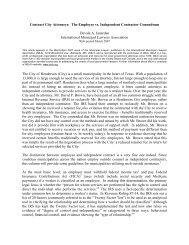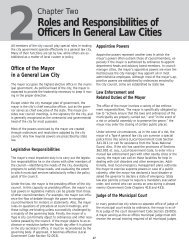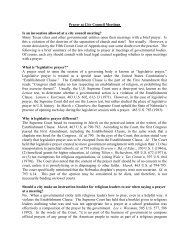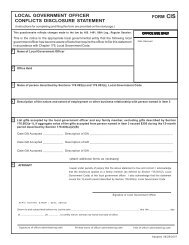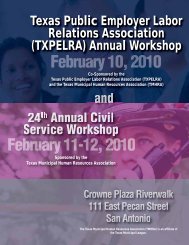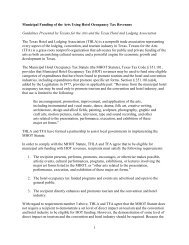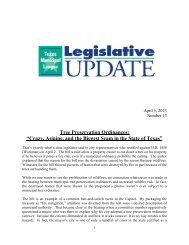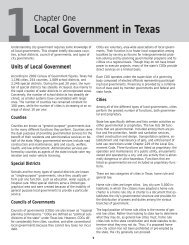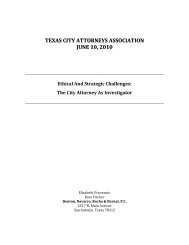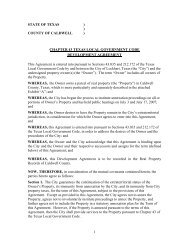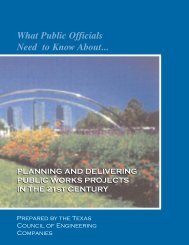Economic Development Basics - Texas Municipal League
Economic Development Basics - Texas Municipal League
Economic Development Basics - Texas Municipal League
Create successful ePaper yourself
Turn your PDF publications into a flip-book with our unique Google optimized e-Paper software.
(2) Pay the principal of, interest on, and other costs relating to bonds orother obligations issued by the city to refund bonds, notes, or otherobligations.(3) Pay the costs of operating or maintaining one or more approved venueprojects.d. What is the benefit to the city of using Chapter 334?B. "Quality of Life" TaxesThe law creates new funding sources for projects with the potential to createadditional revenue for the sponsoring cities. The law is especially beneficialto cities that have reached their local sales tax cap and need additionalrevenue sources. The types of projects permitted under Chapter 334 areprojects that attract visitors to the venue itself as well as to surroundinghotels, restaurants and shops. It is also likely that a venue project will bringnew sources of ad valorem tax revenues to the city through new businessesattracted to the vicinity of the venue. Ideally, additional visitors and newbusinesses will lead to an increase in sales tax revenue to the city's generalfund to pay the costs of running the city (i.e. streets, police, fire, codeenforcement). The venue project funding options authorized by the statuteare the type that will be at least partially funded by the persons visiting thevenues. 31. Local Hotel Occupancy TaxTex. Tax Code Ann. Ch. 351 (Vernon 2002 & Supp. 2004).a. What is the local hotel occupancy tax?A hotel occupancy tax may be imposed against any person who pays for theuse of a room in a hotel. Most cities are eligible to adopt a hotel occupancytax rate of up to seven percent of the consideration paid for the use of a hotelroom. Certain cities, by statute, may impose a hotel occupancy tax at ahigher rate (§ 351.003). The state of <strong>Texas</strong> imposes a six percent hoteloccupancy tax rate. Additionally, a number of counties have receivedlegislative approval to adopt a county hotel occupancy tax not to exceedseven percent of the consideration paid for a hotel room. In certain areas of<strong>Texas</strong>, the combined hotel occupancy tax rate of up to 20 percent of the costof the hotel room may be charged. Hotels are required to charge and collectthe tax, and the hotel remits the tax to the city on a regular basis establishedby the city.b. How is the local hotel occupancy tax imposed?Cities may adopt an ordinance calling for the levy of the tax. Voter approvalis not required, except for a general-law municipality that borders on the Gulfof Mexico and has a boundary that is within 30 miles of Mexico. In thatinstance, the city may increase the rate to a maximum of 7.5 percent if theincrease is approved by a majority of the registered voters voting at theelection held for that purpose. See Tex. Tax Code Ann. § 351.003(d)(Vernon 2004 Supp.) effective June 18, 2003 until January 1, 2006.3 For a comparison of Tex. Civ. Statutes art. 5190.6 § 4B vs. Loc. Gov't Code Chapter 334, see Attachment 2.(9)




